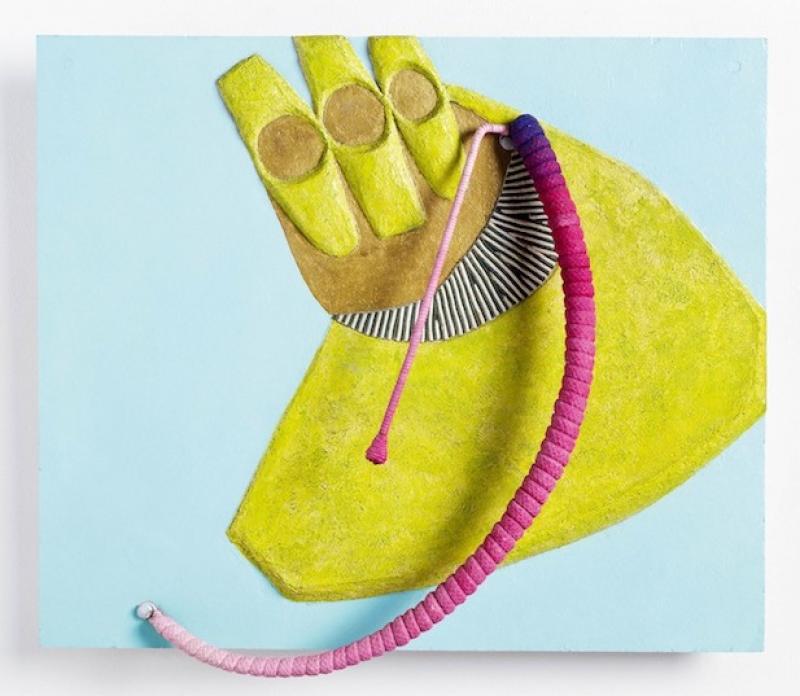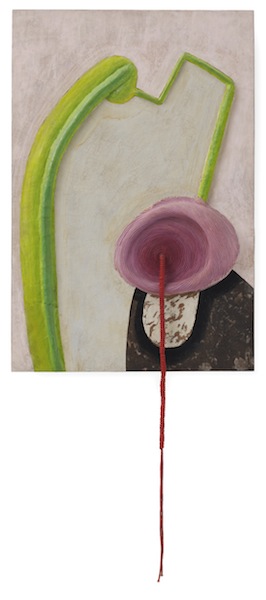Bruce Nauman: Mindfuck / Eva Hesse 1965, Hauser & Wirth, London | reviews, news & interviews
Bruce Nauman: Mindfuck / Eva Hesse 1965, Hauser & Wirth, London
Bruce Nauman: Mindfuck / Eva Hesse 1965, Hauser & Wirth, London
Nauman's mind-body split, and a period of feverish change for Hesse

Bruce Nauman is a great synthesizer of art forms, melding the language games of conceptual art with the physicality of post-minimalist sculpture and performance art. Where the minimalists duplicated the serial and repetitive industrial world around them, Nauman’s use of repetition and order have a linguistic basis. Inculcation, jokes, paradoxes and puns form the logic of much of Nauman’s work and these games grew out of his choreographed minimalist performances.
Filling one of Hauser & Wirth’s huge Savile Row spaces, this small survey of Nauman’s work, called Mindfuck, seeks to “highlight the enduring mind-body split in Nauman’s work” and takes a psychoanalytical approach to its meaning. What we really have here is a giant of post-war art who, true to form, forces us to reimagine what our criteria of judgement could be. Meaning itself is the subject of Nauman’s work.
 The first structure we’re confronted with is the massive Untitled (Helman Gallery Parallelogram, 1971 (pictured right): two narrow, tapering green-lit passageways lead to a pallid green-lit room. This environment bonds the perceptual and the physical though its optical trickery in the use of light. It supposedly represents the body-focused aspect of Nauman’s work, but there’s a cerebral element too; there’s no attempt to disguise the structure of the freestanding work. To walk around the wooden walls gives the work a knowing transparency.
The first structure we’re confronted with is the massive Untitled (Helman Gallery Parallelogram, 1971 (pictured right): two narrow, tapering green-lit passageways lead to a pallid green-lit room. This environment bonds the perceptual and the physical though its optical trickery in the use of light. It supposedly represents the body-focused aspect of Nauman’s work, but there’s a cerebral element too; there’s no attempt to disguise the structure of the freestanding work. To walk around the wooden walls gives the work a knowing transparency.
We squeeze through the other side to be confronted with Sex and Death / Double “69”,1985, a sequence of multi-coloured neon figures continually alternating in oral copulation, one of three neon works which blink frantically in the semi-darkness. Meanwhile, Carousel (Stainless Steel Version), 1988, pulls the cast remains of animals around in a wide orbit. A dog rears with its head thrown back and its front paws aloft off the ground, perpetually reluctant yet dead. Two pieces of carcass float by, one with “1/2 Deer” scrawled on its cleaved surface. Robert Hughes famously called Nauman “dumb”, and there’s certainly something ineffable about this absurd parade of fragmented life. This is horror without the horror, like a phantasmagoria without light. Like the green room, it appears more dreadful for being so transparent, the central motor as much emphasised as the animal remains it carries.
Good Boy, Bad Boy, 1986-87, bears the same name as his earlier seminal video work and spells out the 100 phrases of its script in coloured neon lights. The phrases are repetitious in the manner of a language lesson: “I LOVE, YOU LOVE, THIS IS LOVE. I PAY, YOU PAY, THIS IS PAYMENT” and so on, the mundane mixed with the scatological. Sequentially the words are lit to form random combinations in different colours. The phrases light up in sets and at one point all at once, throwing a spectrum of light across the darkened gallery. In its melding of language, instruction, repetition and light, it is the most compelling of the works in the show, and has a raw, visceral power which the deadpan jokes of the other neons don’t match. It shares much in common with the parallelogram and the carousel: it’s all there to see, its logic is simple, open and exposed. It’s brutal.
Next door is Eva Hesse 1965, a fascinating, museum-class show which centres on the pivotal year in the development of the German-born American sculptor's work. In 1964 Hesse and her husband, Tom Doyle, took up a residency in Kettwig an der Ruhr, Germany, in an abandoned textile factory. Among the scraps of machinery and materials, Hesse began to explore new textures and forms and this show forensically catalogues her artistic development during this crucial period.

The drawings mine a similar vein of imagery, but the variegated daubs are replaced by clean, confident lines. Some drawings bear the arrows of instruction books and flow diagrams.
Her constructions produced from scavenges in the factory evoke toys, cocoons and stamens. One work, Eighter from Decatur, 1965, bears a Ferris wheel-like structure attached to its bottom right corner. Waves made from yolk-coloured rope radiate from its centre. It’s an off-kilter and homespun piece of work, and it’s too easy to think of Hesse as a “feminine minimalist”. There’s a different kind of aesthetic sensibility here, something unique. A cord dangles from An Ear in a Pond, April 1965 (pictured above), and wavers in the breeze from the front door of the gallery. It is made to feel incomplete; the work is, to put it metaphorically, left hanging. That is what is most radical and distinguished about Hesse’s work: her ability to sustain that sense that things haven't quite slotted together. Like the forms in the paintings and drawings, these three-dimensional objects are partial and irresolute.
Included in the show are later “mature” sculptures (Hesse sadly died young, in 1970, aged 34). These are geometric but also soft and corporeal. Sans II, 1968, is a unit of open boxes in a textured, translucent resin; it looks like the scab of a Donald Judd sculpture. But it’s more open-ended than that: it leaves you with an uneasy feeling of wanting that a Judd would satisfy. As you progress, it’s wonderful to see the forms clarify while the underlying visual and poetic ideas bloom.
Explore topics
Share this article
The future of Arts Journalism
You can stop theartsdesk.com closing!
We urgently need financing to survive. Our fundraising drive has thus far raised £49,000 but we need to reach £100,000 or we will be forced to close. Please contribute here: https://gofund.me/c3f6033d
And if you can forward this information to anyone who might assist, we’d be grateful.

Subscribe to theartsdesk.com
Thank you for continuing to read our work on theartsdesk.com. For unlimited access to every article in its entirety, including our archive of more than 15,000 pieces, we're asking for £5 per month or £40 per year. We feel it's a very good deal, and hope you do too.
To take a subscription now simply click here.
And if you're looking for that extra gift for a friend or family member, why not treat them to a theartsdesk.com gift subscription?
more Visual arts
 'We are bowled over!' Thank you for your messages of love and support
Much-appreciated words of commendation from readers and the cultural community
'We are bowled over!' Thank you for your messages of love and support
Much-appreciated words of commendation from readers and the cultural community
![SEX MONEY RACE RELIGION [2016] by Gilbert and George. Installation shot of Gilbert & George 21ST CENTURY PICTURES Hayward Gallery](https://theartsdesk.com/sites/default/files/styles/thumbnail/public/mastimages/Gilbert%20%26%20George_%2021ST%20CENTURY%20PICTURES.%20SEX%20MONEY%20RACE%20RELIGION%20%5B2016%5D.%20Photo_%20Mark%20Blower.%20Courtesy%20of%20the%20Gilbert%20%26%20George%20and%20the%20Hayward%20Gallery._0.jpg?itok=7tVsLyR-) Gilbert & George, 21st Century Pictures, Hayward Gallery review - brash, bright and not so beautiful
The couple's coloured photomontages shout louder than ever, causing sensory overload
Gilbert & George, 21st Century Pictures, Hayward Gallery review - brash, bright and not so beautiful
The couple's coloured photomontages shout louder than ever, causing sensory overload
 Lee Miller, Tate Britain review - an extraordinary career that remains an enigma
Fashion photographer, artist or war reporter; will the real Lee Miller please step forward?
Lee Miller, Tate Britain review - an extraordinary career that remains an enigma
Fashion photographer, artist or war reporter; will the real Lee Miller please step forward?
 Kerry James Marshall: The Histories, Royal Academy review - a triumphant celebration of blackness
Room after room of glorious paintings
Kerry James Marshall: The Histories, Royal Academy review - a triumphant celebration of blackness
Room after room of glorious paintings
 Folkestone Triennial 2025 - landscape, seascape, art lovers' escape
Locally rooted festival brings home many but not all global concerns
Folkestone Triennial 2025 - landscape, seascape, art lovers' escape
Locally rooted festival brings home many but not all global concerns
 Sir Brian Clarke (1953-2025) - a personal tribute
Remembering an artist with a gift for the transcendent
Sir Brian Clarke (1953-2025) - a personal tribute
Remembering an artist with a gift for the transcendent
 Emily Kam Kngwarray, Tate Modern review - glimpses of another world
Pictures that are an affirmation of belonging
Emily Kam Kngwarray, Tate Modern review - glimpses of another world
Pictures that are an affirmation of belonging
 Kiefer / Van Gogh, Royal Academy review - a pairing of opposites
Small scale intensity meets large scale melodrama
Kiefer / Van Gogh, Royal Academy review - a pairing of opposites
Small scale intensity meets large scale melodrama
 Jenny Saville: The Anatomy of Painting, National Portrait Gallery review - a protégé losing her way
A brilliant painter in search of a worthwhile subject
Jenny Saville: The Anatomy of Painting, National Portrait Gallery review - a protégé losing her way
A brilliant painter in search of a worthwhile subject
 Abstract Erotic, Courtauld Gallery review - sculpture that is sensuous, funny and subversive
Testing the boundaries of good taste, and winning
Abstract Erotic, Courtauld Gallery review - sculpture that is sensuous, funny and subversive
Testing the boundaries of good taste, and winning
 Edward Burra, Tate Britain review - watercolour made mainstream
Social satire with a nasty bite
Edward Burra, Tate Britain review - watercolour made mainstream
Social satire with a nasty bite
 Ithell Colquhoun, Tate Britain review - revelations of a weird and wonderful world
Emanations from the unconscious
Ithell Colquhoun, Tate Britain review - revelations of a weird and wonderful world
Emanations from the unconscious

Add comment